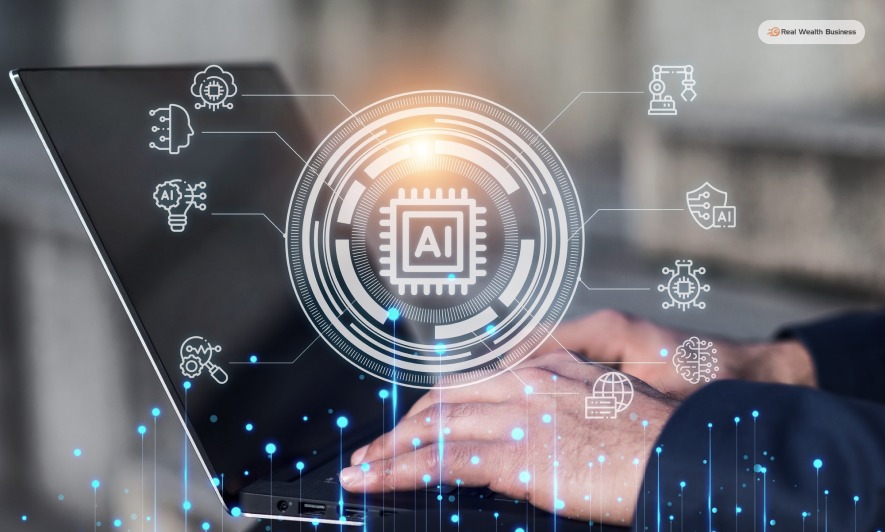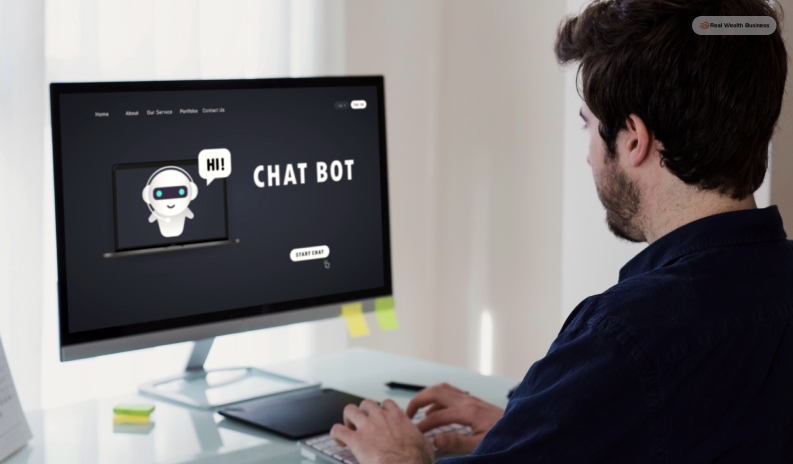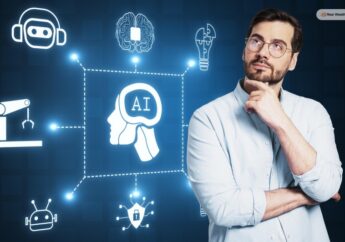Using artificial intelligence for business creativity: 10 Ways To Boost Business Productivity Using AI
by Shahnawaz Alam Business Intelligence 13 February 2024

Artificial intelligence has been helping us break boundaries and come up with unique ideas, creations, and even businesses. AI Instagram influencers and even content creators use AI to make different forms of content and monetize them on diverse platforms. However, using artificial intelligence for business creativity exceeds generating a few forms of content. It has an overarching effect on how fast and how creatively the world of business is changing.
In this article, I have explored how businesses can utilize AI to bring in the creative force and new perspective in running a business.
Different Ways to Use Artificial Intelligence for Business Creativity
Here are ten different ways small business owners can use artificial intelligence for business creativity–
1. Personalized Customer Experience

One of the biggest challenges businesses face is facilitating a better customer experience for all of their customers. The difficulty level goes high with businesses with diverse target demographics.
When there are five different types of customers with five different types of needs and ways of intersecting with a business, the room for personalization shrinks. Almost all customers leave with almost the same experience.
But AI can help. When the audience visits a business website, they interact with it, leaving valuable information behind that links to their emotions, feelings, etc. Also, all those clicks, carted products, visits to the landing pages, and conversions leave enough quantitative marks as well.
You can use modern segmentation techniques coupled with AI assistance to create a personalized experience for your customers in real time.
FYI, a massive 48% of customers expect a personalized experience once they visit a business website. AI can interact and use real-time customer data to boost customer experience. Businesses can use AI as a creative force to boost customer experiences. Here, AI comes as a help –
- Tailored product recommendations
- Custom coupons
- Customized marketing messages
- Proactive engagement
Yes, small businesses lacking extra hands can use AI to automate these processes to satisfy their customers and boost brand loyalty.
2. Business Communication

Since we are talking about using artificial intelligence for business creativity, we cannot cast aside all the help generative AI can offer. Business communication requires an ample amount of data-backed research and written and audio-visual documentation.
Whether presenting an idea or working on your sales presentation, corporate employees can reduce their sleepless nights – all thanks to generative AI. One can work on thorough research using tools like ChatGPT or BARD. They can turn their document into an interactive presentation. Even generating images and creative videos is also possible with creative AI tools.
Corporate workers can leverage AI with Microsoft Copilot. It can help users use the power of AI at different corners of the tool, automate different types of tasks, and save hours. Dall-E is another useful tool for creating original AI-generated images – it opens a new door for businesses. You don’t have to go around buying different images for promotional purposes. Dall-E will generate those for you. Just add in the description, and it will create the image you want.
Starting with images for social media posts and creating engaging infographics, Dall-E, Midjourney, and several other tools are here to change the business landscape. Do you know what benefits businesses will have now? Spend less time looking for resources and more time making money.
3. Chatbots for Customer Support

Anticipate queries and answer them beforehand – this was the process businesses used to follow. Businesses usually have FAQ sections on their website to help customers find answers to common queries. But that’s not enough.
AI chatbots come to revolutionize and improve FAQ sections on business landing pages. Small businesses don’t always have the funds to employ customer support providers. Also, it is difficult to provide 24/7 customer support while also trying to keep operating costs under budget. AI chatbots solve that problem.
Once the customer reaches the landing page or the business page, the AI chatbot appears, always ready with answers to customers’ questions. The chatbot can be the on-page guiding assistant, be it product inquiry or helping customers take the journey through the sales funnel.
Wait, you want examples? E-commerce businesses like Nykaa H & M have great chatbots to help audiences through their purchase experiences.
4. Data Analysis and Insights

There is a vast amount of data circulating on the internet. Businesses are always on the lookout for useful data. But most of the data is unstructured. In fact, the amount of data available is so vast that it is almost impossible to make meaningful insight out of it – for a real human being, that is.
But it’s not a problem AI cannot solve. This is where one can use AI as a creative force in business. Small businesses can use AI algorithms and analyze vast amounts of data ( both structured and unstructured) to make out valuable insights.
In fact, businesses are now using Intelligent decision support systems powered by AI.
So, how far can AI take your data analysis? Here are some untapped potential your business might have not thought about… not yet!
- Analyze market trends.
- Identify customer behaviors.
- Operational data.
These are undoubtedly the most important data sets and are helpful for businesses. Using AI models, businesses can identify patterns, anomalies, correlations, and trends in the data. Of course, we can use human intelligence and take all the time in the world to do it. But is that feasible? I’ll let you decide.
However, there is a chance of AI becoming biased and providing wrong insights. AI uses machine learning to learn from inputs provided by humans. If incorrect and biased data creeps into the database, the results can be corrupted.
5. Product Prototyping & Designs

Businesses don’t want to spend hours, weeks, or months collecting and analyzing data to design a new product. This is where we businesses use AI as a creative force in business and automate market research, selecting inspirations and competitors and analyzing them.
It can help with predictive analysis quickly and summarize gigabytes of unstructured data to provide insights. Through generative AI, businesses can automate rapid prototyping of different product designs. It uses sketches, texts, and different inputs to help through the ideation stage.
In fact, there is more to it than we anticipated. AI can check and analyze users’ interactions on a product website and provide insights like why certain buttons are helpful and why something is not working. Overall, product designers can leverage AI tools to understand how certain products will behave and their response to different strains and loads. These are just the tip of the iceberg. AI will help automate the analysis of user behaviors and run virtual product tastes.
So, a small business can visualize a product before creating a prototype and testing it in the market. Yes, since data back everything, it will provide a clear way forward.
6. Supply Chain Optimisation

Businesses can use artificial intelligence for business creativity and creatively optimize their supply and demand, maintain proper inventory, and sell significantly. Many businesses often find it difficult to keep track of their inventory. Running out of sellable products when the demand is high does not feel good.
This is when AI can come to the rescue. It reduces the chance of human error by managing the inventory correctly. So, there is hardly any chance of stock overload or low inventory. So, the business has more time in its hands for better administration and management.
AI and ML principles help with proper demand forecasting, helping the business stay alert for a good market opportunity and grab it when it arrives. AI & ML help analyze and align a product’s end-of-life on a sales channel with the constantly shifting market state.
You can use artificial intelligence for business creativity, and these supply chain-related solutions will prove the creativity businesses can unleash with AI –
- Integration of AI into supply chain management will take out high operational costs.
- A lot of the manual tasks will be automated, reducing up to 40% of the organization’s repetitive and employee-heavy tasks.
- AI can help maintain a proper chain of communication between suppliers, retailers, planners, sellers, and other stakeholders.
- AI can help businesses shorten the delivery time and satisfy the customers with timely delivery, maintaining better business relationships. On top of everything, AI in business and supply chain management can bring in the revolution with the integration of decision support systems.
7. Dynamic Pricing Strategies

AI-driven pricing strategies go a long way toward helping businesses of today’s time. Many businesses miss out on significant numbers and qualities of customers just because of a wrong product pricing. AI can help beat this confusion through dynamic pricing strategies.
At the base of different strategies and personalized tools, there is machine learning that analyzes the right metrics and puts them to the right kind of work.
AI can help small businesses analyze metrics like –
- Market trends
- Customer behavior
- Competitor pricing
Companies can use all those metrics to build a proper pricing strategy for their products. Small businesses adjust their product pricing based on those metrics, improving their revenue growth in a competitive market.
AI uses machine learning to analyze historical pricing data, customer interaction, market conditions, and dynamic responses to different pricing. This automation helps businesses optimize their pricing strategies when needed. Where there is harmonious strategy, there is creativity, and businesses can use artificial intelligence for business creativity – especially when it requires a dynamic strategy for pricing.
8. Human Resources and Recruitment

AI has already started to change and revolutionize human resource departments across the world and across different industries. It can take out tons of manual work, starting from talent spotting to reaching, hiring, and onboarding.
Starting from creating a job post to reaching different employees and taking them through the entire employee lifecycle needs lots of work. AI can automate a lot of that work. It can help analyze resumes and screen potential candidates with optimal speed. Small businesses will find the talent-spotting process easy, like a cakewalk.
Even the onboarding process becomes a lot easier with generative AI taking care of some of the most important tasks like –
- Employee document verification.
- Conducting induction training
- Running administrative tasks like – providing IDs and employee access to softwares and hardwares.
Also, AI is going to help the HR department detect anomalies in employee behaviors and potential violations of certain company policies. This takes out the need for manual employee monitoring and makes the process transparent and easy for the HR department.
In addition to that, the learning and development department of the organization can also automate their work using AI. The L&D department can use AI to select courses, identify skill gaps, and improve employees’ performances and skills.
Small businesses can use artificial intelligence for businesses creatively, and AI integration in the HR department is one of them.
9. Predictive Maintenance

Production downtime is one of the deadliest enemies of businesses. So businesses have to be proactive with their maintenance, and generative AI can come to the rescue here as well. The technology can predict maintenance needs according to data analysis. It helps businesses avoid downtimes and predict their maintenance-related needs using data analysis.
AI uses data analysis and historical data to forecast failures or potential success. Accordingly, businesses can use it for scheduling maintenance work. Thanks to AI integration, businesses will avoid costly downtimes. It proactively addresses maintenance requirements. Businesses won’t have trouble running operations thanks to AI.
10. Business Idea Generation

Figuring out a business and running it is a creative process. Starting from idea generation, creating plans, and building product or service prototypes – all of these creative works can be done using AI.
Businesses can use generative AIs to merge their ideas with data and create business plans. In fact, it will also come in handy in project management and business operations.
However, one needs to have a clear objective, use the right AI tools, and provide context to the AI tool for generating ideas. Proper prompt engineering with generative AI will facilitate great ideas for business owners ( provided that the data and context given are accurate.)
Final Words
AI is nothing new. It has been with us for quite some time. But now, it is more prominent than ever, and it will only get more intense. Little by little, in the coming decade, it will be present across different businesses, and businesses will eventually use artificial intelligence for business creativity. If you have not already, this article should help you with some perspective as to how your business will benefit from AI integration. Hopefully, this article was of value to you. Please share your opinion on the same in the comment section.
Thank you for reading.
For More Business Related Article Click Below!!



































































































